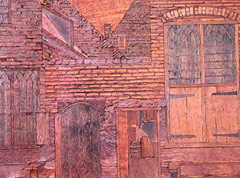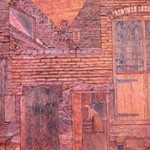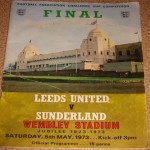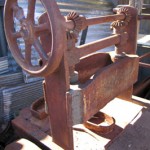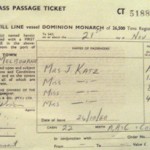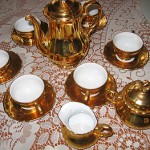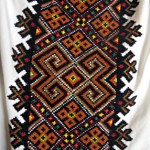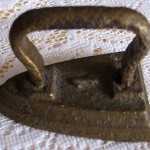Dutch
Zaandyk, Holland
Rotterdam, Holland in October 1950
Sydney on 30 November 1950
Bathurst for 2 months
‘Rowlee’ orchard, Nashdale, near Orange
My father Joe was an orchard hand at ‘Rowlee’, Nashdale, near Orange
My father was also a carpenter for Emmco, Fred Morgan’s joinery shop and Kloosterman builders in Orange.
I was 11 when we came out here. I was born in Zaandyk [Holland] and we lived near a water sports resort. I remember [in WW2] planes flying over towards Germany and I remember bombs being dropped. Dad was of an age where he could be transported to Germany to work in factories and he was always in hiding. The Germans would conduct raids to pick up people and apparently I was told never to speak to Germans. A lot of people, out of sheer desperation, would steal food. I remember Dad roasting chestnuts to make coffee.
After the war the bureaucracy that took over – he found it very difficult to re-establish his boat building business. The people who collaborated with the Germans had materials to use.
He looked at South Africa, Canada and Australia to migrate. Because he was a tradesman he didn’t get an assisted passage. Virtually all his possessions had to be sold for the trip. We brought with us a framed marquetry picture made by my grandfather of a famous Vermeer painting titled ‘Little Street’.
My grandfather was actually a piano tuner but he loved woodwork and he used to do pictures for a hobby. He had already promised it to Dad before he’s finished it, saying, ‘If I die before I finish it, you’re the only one who could finish it’. Dad always loved working with timber and he was a very good carpenter. He took the picture to Australia as a memento of him.
We arrived in Sydney on 30 November 1950 and took the train to the Bathurst hostel. In January 1951 we moved to ‘Rowlee’, a property at Nashdale and stayed there for about 14 months. Then we went to the Armstrong orchard at Nashdale for the fruit season. Dad was picking apples and pears by day and at night he was making wooden apple boxes in the shed.
Then we moved to Orange and Dad bought a block of land in Tynan Street from his savings and we put an old caravan on the block. It turned out not to be our block but we stayed there. So Dad built a toilet on the right block. This would have been in 1952. When he came here he got a job in the carpentry shop at Emmco making moulds for fridge doors. He did his trade as a carpenter but his first love was boat building. From there he went to Fred Morgan’s joinery shop in Warrendine Street. After that he partnered up with a couple of other Dutch people. He had to go to ‘tech’ to show proficiency in carpentry. He didn’t even have to finish the project because they could see he knew what to do. The three of them did paling fences and fence building and house extensions. The partnership broke up and Dad went to work with Bill Kloosterman [local builder] for a while. That split up and Dad went on his own.
In the ’60s his love of boats and water sports came to the fore and he was instrumental in starting the Orange Sailing and Canoeing Club in August 1960. We started by building three kayaks and we paddled them on Lake Canobolas. We were inundated by people wanting to try it and Dad made a mould for a fibreglass kayak.
That was his main interest but he had to have an income. He was always too cheap, too honest. Because of going through the 1930s Depression, he was always going to ridiculous lengths to save money on materials.
My grandfather was actually a piano tuner but he loved woodwork and he used to do pictures for a hobby. He had already promised it to Dad before he’s finished it, saying, ‘If I die before I finish it, you’re the only one who could finish it’. Dad always loved working with timber and he was a very good carpenter. He took the picture to Australia as a memento of him.
I had one year in the two-teacher school at Nashdale. It didn’t take long to learn English. The kids took great delight in teaching me to swear! Because I couldn’t speak English they stuck me in fourth class at Nashdale, then after about six weeks they put me in fifth class, then to sixth class. I was the only Dutch kid at the school so there was no choice – you had to learn English. The following year I went to Orange High School where the TAFE is now.
The Dutch people started up a Dutch community group which was very helpful in the early years but most Dutch people assimilated. They took part in community activities – I can remember clog dancing at Wade Park. When Holland was guest nation at the Field Days some of the Dutch community got involved in that.
Tynan Street used to be a stock route so we had regular mobs of cattle and sheep and some horses going past the houses. A few of the migrant children in Tynan Street were at high school with me. John Kich and his sisters Olga and Voiciss, Hallowen and Babij. The first three houses were all Australian, the rest were virtually all migrants – Cudars, Smolle etc. There was a mix of nationalities including Dutch, Ukrainian, Czech, Latvian etc.


